Defining spatially-varying dielectric structures#
When a regular Tidy3D Medium or a dispersive medium such as Lorentz is assigned to a Structure, the refractive index is homogeneous within the geometry. In some cases, such as gradient-index optics
component and inhomogeneous doped structure simulations, a spatially varying refractive index distribution is desirable. In principle, this can be achieved by manually dividing the Structure into smaller sub-components and assigning a refractive index value to each component according to the spatial distribution. However, this process can be tedious and error-prone. Fortunately, Tidy3D
supports both non-dispersive and dispersive media that have a spatially varying refractive index, and thus can help you achieve this result very conveniently.
In this tutorial, first we illustrate how to define structures made of custom non-dispersive medium called CustomMedium that allow for a customized refractive index spatial profile. An example is an ideal gradient index lens that has flat surfaces but a parabolic distribution of refractive index. The simulation result allows us to examine the focusing capability of the lens.
Next, we illustrate how to define structures made of custom dispersive medium. As an example, we construct a lens made of CustomLorentz that has the ideal refractive index distribution at the frequency of interest.
Finally, we explain how to construct a diagonally anisotropic medium in which each component can be independently defined as any type of custom dispersive or non-dispersive medium.
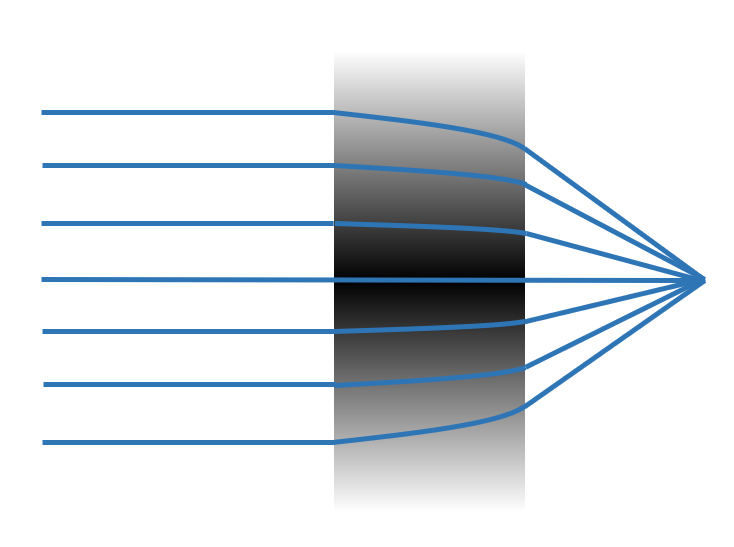
If you are new to the finite-difference time-domain (FDTD) method, we highly recommend going through our FDTD101 tutorials.
[1]:
import numpy as np
import matplotlib.pyplot as plt
import xarray as xr
import tidy3d as td
from tidy3d import web
from tidy3d import SpatialDataArray
The lens is designed to work at 1 \(\mu m\) wavelength.
[2]:
lda0 = 1 # central wavelength
freq0 = td.C_0 / lda0 # central frequency
Custom Non-dispersive Medium#
With CustomMedium, one can customize the spatial profile of non-dispersive refractive index inside a structure. The spatial profile is defined with SpatialDataAarray where we provide scalar data such as refractive index and labeled coordinates. Below, let’s see how to define a flat lens whose index of refraction follows \(n(r)=n_0(1-Ar^2)\), where \(r\) is the radial distance to the \(z\)-axis. In this particular example, we study a lens of 20 \(\mu m\) radius and 10 \(\mu m\) thickness.
First, we define the spatial grids. The refractive index is invariant alone \(z\)-axis, and varies in the \(x\)-\(y\) plane. For the uniform \(z\)-axis, we only need to supply one grid point since CustomMedium will automatically generate uniform profiles along the axis where a single grid point is supplied. In the \(x\) and \(y\) dimensions, we set 100 grid points to fully resolve the refractive index variation.
[3]:
Nx, Ny, Nz = 100, 100, 1 # number of grid points along each dimension
r = 20 # radius of the lens, unit: micron
t = 10 # thickness of the lens, unit: micron
# The coordinate for the refractive index data that includes x, y, z, and frequency
# Note: when only one coordinate is supplied along an axis, it means the medium is uniform along this axis.
X = np.linspace(-r, r, Nx) # x grid
Y = np.linspace(-r, r, Ny) # y grid
Z = [0] # z grid
Next, we define a 3-dimensional array that stores the refractive index.
[4]:
# define coordinate array
x_mesh, y_mesh, z_mesh = np.meshgrid(X, Y, Z, indexing="ij")
r_mesh = np.sqrt(x_mesh**2 + y_mesh**2) # radial distance
# index of refraction array
# assign the refractive index value to the array according to the desired profile
n_data = np.ones((Nx, Ny, Nz))
n0 = 2
A = 1e-3
n_data[r_mesh <= r] = n0 * (1 - A * r_mesh[r_mesh <= r] ** 2)
Finally, we convert the numpy array to a SpatialDataArray that labels the coordinate.
[5]:
# convert to dataset array
n_dataset = SpatialDataArray(n_data, coords=dict(x=X, y=Y, z=Z))
Defining CustomMedium in 3 Ways#
Here, we will illustrate defining custom medium in three different ways: 1. Using classmethod td.CustomMedium.from_nk when refractive index and extinction coefficients are readily available. 2. Using classmethod
td.CustomMedium.from_eps_raw to supply permittivity data, which can be complex-valued for lossy medium. 3. Define permittivity and conductivity directly in td.CustomMedium.
(One can also define permittivity for each component separately via PermittivityDataset, but it is to be deprecated in the future. For custom medium that is anisotropic, it is encouraged to define through CustomAnisotropicMedium)
In any of the three ways, you can optionally define how the permittivity is interpolated to Yee-grid with interp_method that can take the value of “linear” or “nearest”. The default value is “nearest”. If the custom medium is applied to a geometry larger than the custom medium’s grid range, extrapolation is automatically applied for Yee grids outside the supplied coordinate region. When the extrapolated value is smaller (greater) than the minimal (maximal) of the supplied data, the
extrapolated value will take the minimal (maximal) of the supplied data.
[6]:
## Three equivalent ways of defining custom medium for the lens
# define custom medium with n/k data
mat_custom1 = td.CustomMedium.from_nk(n_dataset, interp_method="nearest")
# define custom medium with permittivity data
eps_dataset = n_dataset**2
mat_custom2 = td.CustomMedium.from_eps_raw(eps_dataset, interp_method="nearest")
# define permittivity directly in the class
mat_custom3 = td.CustomMedium(permittivity=eps_dataset, interp_method="nearest")
Note that when the medium is lossy so that k is non-zero and permittivity is complex-valued, in Approach 3, one can directly define the conductivity in the class:
mat_custom3 = td.CustomMedium(permittivity=eps_dataset, conductivity=conductivity_dataset, interp_method="nearest")
In the other two approaches, the frequency value at each the complex-valued permittivity or n/k is defined is needed to evaluate the conductivity. There are two ways to supply the frequency information:
Pass through
freqkwarg in the classmethod td.CustomMedium.from_nk and td.CustomMedium.from_eps_rawSupply
n/kor permittivity through ScalarFieldDataArray that contains a frequency coordinate.
Simulation Setup#
Define Lens Structure#
[7]:
# define the lens structure as a box
lens = td.Structure(
geometry=td.Box(center=(0, 0, t / 2), size=(td.inf, td.inf, t)), medium=mat_custom1
)
Define a Source and Monitor#
[8]:
# define a plane wave source
plane_wave = td.PlaneWave(
source_time=td.GaussianPulse(freq0=freq0, fwidth=freq0 / 20),
size=(td.inf, td.inf, 0),
center=(0, 0, -lda0),
direction="+",
pol_angle=0,
)
# define a field monitor in the xz plane at y=0
monitor_field_xz = td.FieldMonitor(
center=[0, 0, 0], size=[td.inf, 0, td.inf], freqs=[freq0], name="field_xz"
)
[10:33:55] WARNING: Default value for the field monitor monitor.py:261 'colocate' setting has changed to 'True' in Tidy3D 2.4.0. All field components will be colocated to the grid boundaries. Set to 'False' to get the raw fields on the Yee grid instead.
Define a Simulation#
[9]:
# simulation domain size
Lx, Ly, Lz = 2 * r, 2 * r, 5 * t
sim_size = (Lx, Ly, Lz)
run_time = 2e-12 # simulation run time
# define simulation
sim = td.Simulation(
center=(0, 0, Lz / 2 - lda0),
size=sim_size,
grid_spec=td.GridSpec.auto(min_steps_per_wvl=10, wavelength=lda0),
structures=[lens],
sources=[plane_wave],
monitors=[monitor_field_xz],
run_time=run_time,
boundary_spec=td.BoundarySpec.all_sides(
boundary=td.PML()
), # pml is applied in all boundaries
symmetry=(
-1,
1,
0,
), # symmetry is used such that only a quarter of the structure needs to be modeled.
)
Visualize the Simulation and Gradient Index Distribution#
We can use the plot_eps method of Simulation to visualize the simulation setup as well as the permittivity distribution.
First, plot the \(yz\) plane at \(x\)=0.
[10]:
sim.plot_eps(x=0)
plt.show()
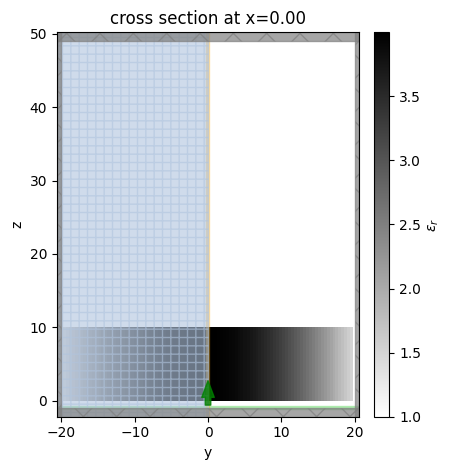
Similarly, plot the \(xy\) plane at \(z\)=0. The spatially varying permittivity is clearly observed.
[11]:
sim.plot_eps(z=t / 2)
plt.show()
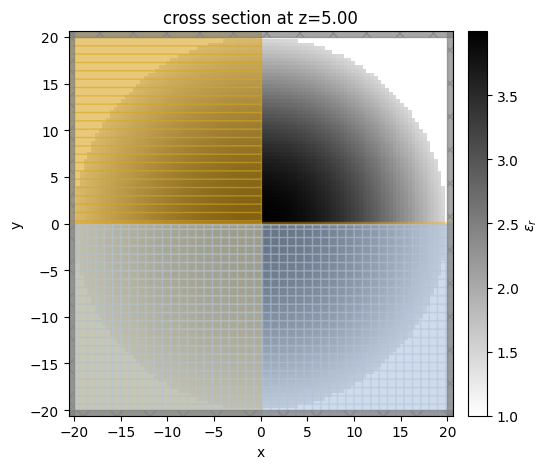
Submit Simulation Job#
Submit the simulation job to the server.
[12]:
sim_data = web.run(
sim,
task_name="gradient_index_lens",
path="data/simulation.hdf5",
verbose=True,
)
View task using web UI at webapi.py:190 'https://tidy3d.simulation.cloud/workbench?taskId=fdve- 7a48ecdf-e30c-45b4-beaf-37a743536d5av1'.
Result Visualization#
After the simulation is complete, we can inspect the focusing capability of the gradient-index lens by plotting the field distributions. First, plot \(E_x\) in the \(xz\) plane at \(y=0\).
[13]:
sim_data.plot_field("field_xz", "Ex", vmin=-15, vmax=15)
plt.show()
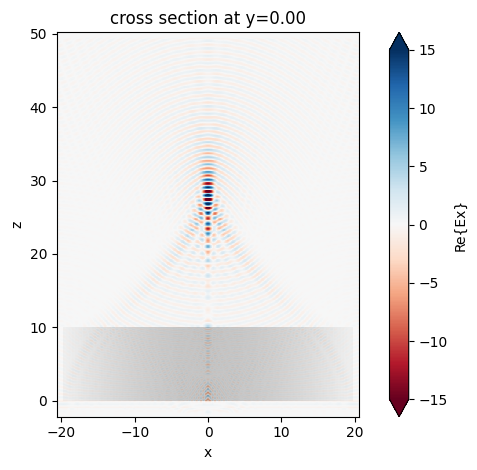
The focus is better visualized by plotting the field intensity. A strong focus about 17 \(\mu m\) from the front surface of the lens is observed.
[14]:
sim_data.plot_field("field_xz", "E", "abs^2", vmin=0, vmax=300)
plt.show()
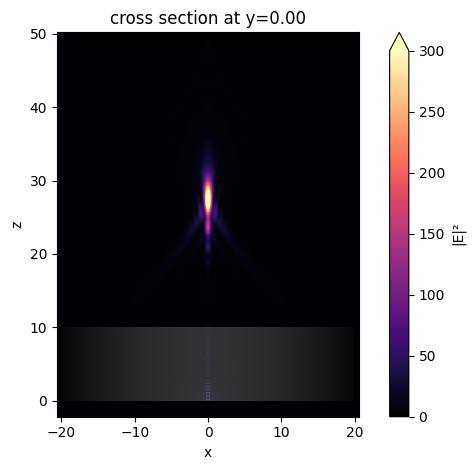
Custom Dispersive Medium#
Tidy3d supports a set of dispersive media: PoleResidue, Lorentz, Sellmeier, Drude, and Debye. Each of them has been generalized to support spatially varying profile. The class for spatially varying medium has a prefix “Custom”. For example, we can define a spatially varying Lorentz model with CustomLorentz class.
The usage of the “Custom” dispersive medium class is very similar to that of the regular medium. When defining a custom dispersive medium object, we simply replace the input fields that are scalar in the regular medium with SpatialDataAarray, which defines the spatial profile with labeled coordinates. Take Lorentz model as an example, there are two input fields: a scalar eps_inf that
defines the relative permittivity at infinite frequency, and a nested tuple of scalar coeffs that defines the oscillator properties including oscillator strength, frequency, and damping rate. In CustomLorentz, the scalar eps_inf turns into SpatialDataAarray, and the nested tuple
of scalar coeffs turns into a nested tuple of SpatialDataAarray. An example is illustrated below:
[15]:
# spatially varying Lorentz model that has the same permittivity profile as
# the custom non-dispersive medium at `freq0`.
eps_inf_dataset = xr.ones_like(eps_dataset) # uniform eps_inf
f0_dataset = xr.ones_like(eps_inf_dataset)*2*freq0 # uniform oscillator frequency as well
gamma_dataset = xr.zeros_like(eps_inf_dataset) # lossless oscillator
delep_dataset = (eps_dataset-1)*3/4 # non-uniform oscillator strength
mat_lorentz = td.CustomLorentz(eps_inf=eps_inf_dataset, coeffs=((delep_dataset, f0_dataset, gamma_dataset),))
Note that all input fields must be defined over the same spatial grids. In this example, the data of eps_inf and all terms in coeffs are defined over the same spatial grids.
Setup Simulation with Spatially Varying Lorentz Medium#
[16]:
lens_lorentz = lens.copy(update={"medium":mat_lorentz})
sim_lorentz = sim.copy(update={"structures":[lens_lorentz]})
Visualize the Simulation and Gradient Index Distribution#
Let’s visualize the simulation on the same plane as before. To view the permittivity distribution at freq0, we set the kwarg freq=freq0. The permittivity distribution at freq0 looks the same as the previous custom non-dispersive medium example.
[17]:
sim_lorentz.plot_eps(x=0, freq=freq0)
plt.show()
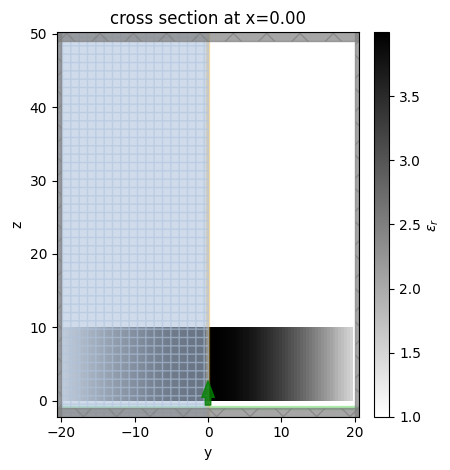
[18]:
sim_lorentz.plot_eps(z=t / 2, freq=freq0)
plt.show()

Submit Simulation Job#
Submit the simulation job to the server.
[19]:
sim_data_lorentz = web.run(
sim_lorentz,
task_name="gradient_index_lens_lorentz",
path="data/simulation_lorentz.hdf5",
verbose=True,
)
View task using web UI at webapi.py:190 'https://tidy3d.simulation.cloud/workbench?taskId=fdve- e9f874ea-d6f4-4b69-b465-7cde786f49aav1'.
Result Visualization#
After the simulation is complete, we inspect the focusing capability of the gradient-index lens by plotting the field distributions on the same plane as before. Again, at freq0, the result is consistent with the previous simulation.
[20]:
sim_data_lorentz.plot_field("field_xz", "Ex", vmin=-15, vmax=15)
plt.show()
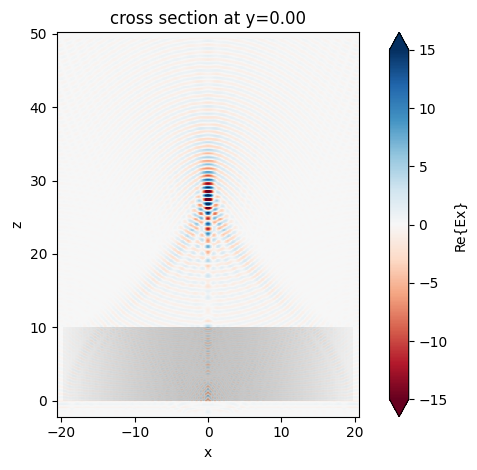
[21]:
sim_data_lorentz.plot_field("field_xz", "E", "abs^2", vmin=0, vmax=300)
plt.show()
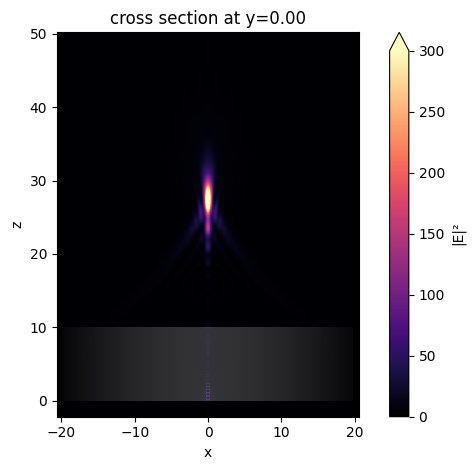
Custom Anisotropic Medium#
With CustomAnisotropicMedium, one can define a diagonally anisotropic medium in which each component is spatially varying. The usage of CustomAnisotropicMedium is similar to AnisotropicMedium, except that each of its components is a spatially varying medium.
In the following, we illustrate how to define a spatially varying anisotropic medium. We define a medium that is dispersive in the zz-component, but non-dispersive in the xx and yy components. At freq0, the medium behaves isotropically, and is identical to the previous custom non-dispersive medium.
Setup Simulation with Spatially Varying Lorentz Medium#
[22]:
mat_anisotropic = td.CustomAnisotropicMedium(xx=mat_custom1, yy=mat_custom2, zz=mat_lorentz)
[23]:
lens_anisotropic = lens.copy(update={"medium":mat_anisotropic})
sim_anisotropic = sim.copy(update={"structures":[lens_anisotropic]})
Visualize the Simulation and Gradient Index Distribution#
Let’s visualize the simulation on the same plane as before. To view the permittivity distribution at freq0, we set the kwarg freq=freq0. The permittivity distribution at freq0 looks the same as the previous custom non-dispersive medium example.
[24]:
sim_anisotropic.plot_eps(x=0, freq=freq0)
plt.show()
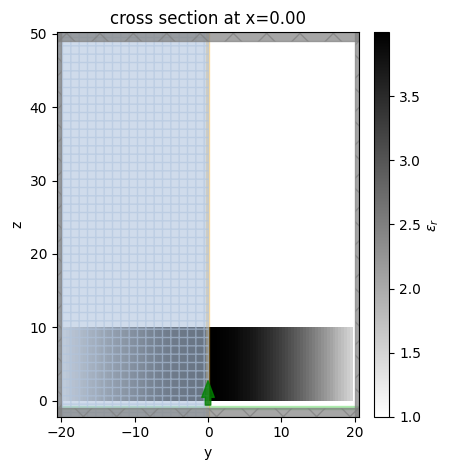
[25]:
sim_anisotropic.plot_eps(z=t / 2, freq=freq0)
plt.show()
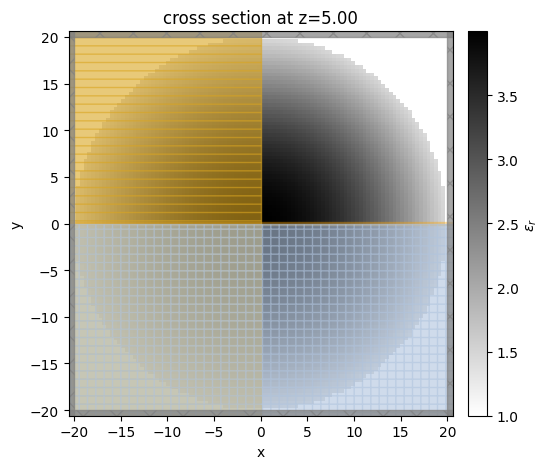
Submit Simulation Job#
Submit the simulation job to the server.
[26]:
sim_data_anisotropic = web.run(
sim_anisotropic,
task_name="gradient_index_lens_anisotropic",
path="data/simulation_anisotropic.hdf5",
verbose=True,
)
View task using web UI at webapi.py:190 'https://tidy3d.simulation.cloud/workbench?taskId=fdve- 413b9013-4dc4-4e2d-a1ee-b66416f14d35v1'.
Result Visualization#
After the simulation is complete, we inspect the focusing capability of the gradient-index lens by plotting the field distributions on the same plane as before. Again, at freq0, the result is consistent with the previous simulation.
[27]:
sim_data_anisotropic.plot_field("field_xz", "Ex", vmin=-15, vmax=15)
plt.show()
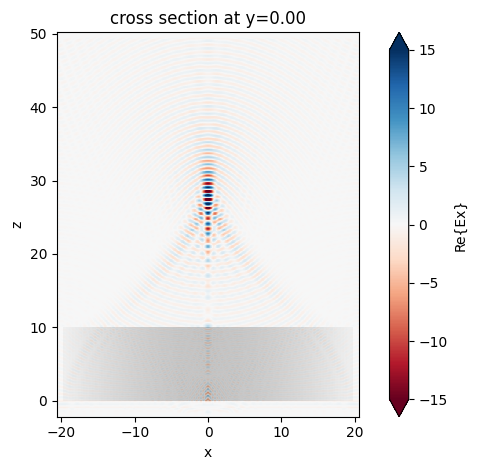
[28]:
sim_data_anisotropic.plot_field("field_xz", "E", "abs^2", vmin=0, vmax=300)
plt.show()
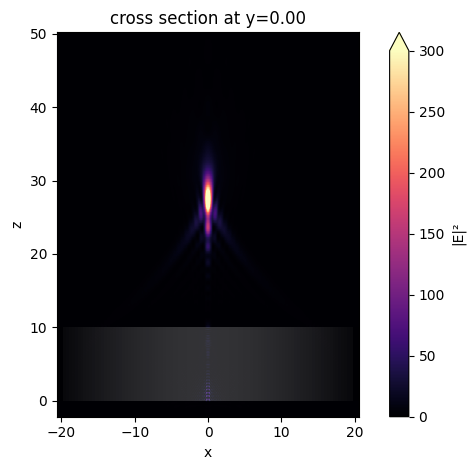
Notes:#
By default, subpixel averaging is off on the surface and inside the structure made of custom medium. To apply subpixel on the interface of the structure, including exterior boundary and intersection interfaces with other structures, please set the field
subpixel=Truein custom medium. Here is an example on setting this option in the custom dispersive medium:
[29]:
mat_lorentz = td.CustomLorentz(
eps_inf=eps_inf_dataset,
coeffs=((delep_dataset, f0_dataset, gamma_dataset),),
subpixel=True,
)
